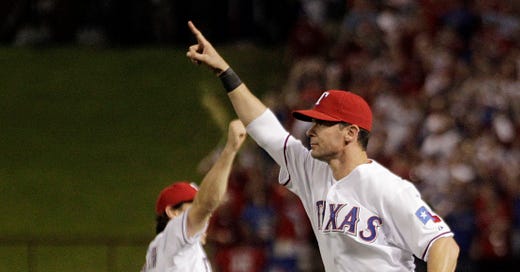T.R.'s Memoirs: Retracing the steps taken by Texas Rangers as they built World Series teams (Part I)
The first step came 10 years before the 2010 club won the first of two straight American League pennants.

Editor’s note: T.R. Sullivan covered the Texas Rangers over 32 years for the Fort Worth Star-Telegram and MLB.com and is sharing his “memoirs” with this newsletter. In the first of a two-part series, Sullivan reviews how the Rangers built their World Series teams.
The Rangers went to two straight World Series in 2010 and 2011, accomplishing something that took them 38 years to do after arriving in Arlington.
They did it without “tanking.”
They did it without employing the strategy now part of the dispute between the Major League Baseball and the Players Association, a lockout that has preempted the start of spring training and threatens to delay the regular season.
The Rangers did not tear down the franchise to ground zero, suffer through multiple 100-loss seasons and stockpile multiple high draft picks to form the core of their championship team. The Rangers did not “tank” games to compile high draft picks while they were trying to rebuild.
That was the alleged plan undertaken by the Astros, and it seemed to work well. The Astros won the World Series in 2017 and continued their success built around former high draft picks Alex Bregman, Carlos Correa and George Springer.
Yes, the Rangers weren’t very good for much of the decade preceding the World Series run. They had one winning season in a nine-year stretch between 2000-08. However, the most they ever lost in one season was 91 games.
From 2011 to 2013, the Astros lost 106, 107 and 111 games. They were the very definition of tanking. Other teams have tried the same approach, but not with the same success as the Astros.
The Rangers won back-to-back division titles in 1998-99 before a stretch where they had two winning seasons over 10 years. During that span, they had three general managers and four managers.
There were also plenty of bad personnel decisions, ranging from signing Chan Ho Park to a six-player trade with the Padres that cost them two valuable young players in Chris Young and Adrian Gonzalez. There were some bad draft picks and some ill-advised gambles that didn’t go as well as expected. Remember John Rocker? Ruben Rivera? Einar Diaz? Brad Fullmer? Ricard Hidalgo?
But, for the most part, the Rangers always went into a season with the intent and hope of at least trying to compete for a division title. Some years, those hopes were more realistic than others, but no season – well, maybe 2003 – was viewed as totally hopeless on Opening Day. But even 2003 brought hope because Buck Showalter had just taken over as manager.
Through it all the Rangers made enough smart moves to put together two pennant-winning teams. General manager Jon Daniels and his front-office lieutenants deserve much of the credit. Former general managers Doug Melvin and John Hart had their imprints on the final product as well.
It wasn’t easy and it didn’t happen nearly as quickly as owner Tom Hicks wanted.
But “tanking” was never a part of the Rangers’ vocabulary and never part of the plan.
On the contrary, the Rangers built their championship teams while Hicks was dealing with financial problems that resulted in the club being auctioned off in bankruptcy court. Club president Nolan Ryan gave the Rangers a presence of stability but could hardly do anything about the club’s dire financial situation.
That wouldn’t be solved until Pittsburgh lawyer Chuck Greenberg, who owned multiple minor-league teams, put together a financial powerhouse group led by Ray Davis of Dallas and Bob Simpson of Fort Worth. Ryan also threw in with them, and Davis-Simpson outbid a group led by Mavericks owner Mark Cuban and future Astros owner Jim Crane to win control of the Rangers in an auction held Aug. 4, 2010.
The sale took place just over 10 years after the Rangers took the first step in acquiring the player who would serve as the heart and soul of the 2010-11 World Series teams.
Michael Young.



